<< Previous | Displaying results 4126-4150 of 6771 for "" | Next >>
The Kobe Municipal Office issued this English-language tourist guide to Kobe and its environs. Jewish refugees in Kobe used such pieces of information. Kobe, Japan, 1940-1941. [From the USHMM special exhibition Flight and Rescue.]

The Kobe Municipal Office issued an English-language tourist guide to Kobe and its environs. The tourist map of Kobe pictured here was included with the guide. Jewish refugees in Kobe used such pieces of information. Kobe, Japan, 1940-1941. [From the USHMM special exhibition Flight and Rescue.]
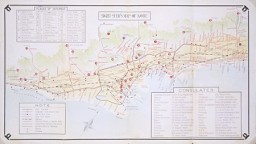
A souvenir stamp book that belonged to a Jewish refugee. The book contains multicolored stamps inscribed with dates and place names. May 1941, Kobe, Japan. [From the USHMM special exhibition Flight and Rescue.]

The table of contents from a Japanese-German phrase book purchased by German Jewish refugees shortly after their arrival in Japan. The phrase book offers useful expressions in Japanese relating to travel, hotel stays, eating, and shopping in Japan. Japan, 1940-1941. [From the USHMM special exhibition Flight and Rescue.]
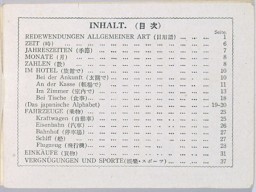
A few Polish Jewish refugees left Japan to join a small Jewish community in Harbin, Manchuria, in Japanese-occupied China. One of them carried this suitcase, covered with stickers from various shipping firms and hotels, on the journey to Harbin. China, 1940-1941. [From the USHMM special exhibition Flight and Rescue.]
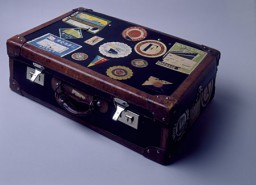
A small group of Jewish refugees left Japan to join a small Jewish community in Harbin, Manchuria, in Japanese-occupied China. This image shows the interior of a leather suitcase carried by one of them to Harbin, China, 1940-1941. [From the USHMM special exhibition Flight and Rescue.]
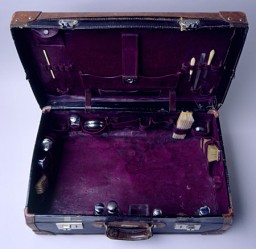
Notebook of Josef Fiszman, a refugee writer from Warsaw. He sold articles to Jewish newspapers in Shanghai and Harbin but still needed help to live from the American Jewish Joint Distribution Committee. Writing in Yiddish, Fiszman rotated the notebook in order to write from right to left (the words "Note book" thus appear to be upside down in this image). [From the USHMM special exhibition Flight and Rescue.]
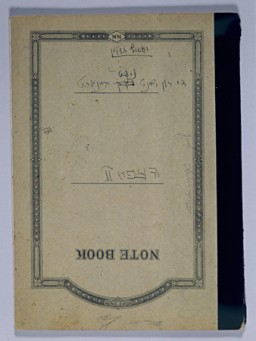
Yiddish writings of Josef Fiszman, a refugee writer from Warsaw. These are some Inside pages of a Fiszman's journal. The journal was written in Shanghai and is entitled "The Sun Never Shines At Night." [From the USHMM special exhibition Flight and Rescue.]
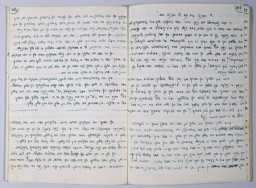
These ice skates were among the few personal belongings Hanni Sondheimer took with her on her journey from Kaunas (Kovno) to Shanghai. Hanni, who was then only a teenager, also carried a pair of red shoes and a picture of Gary Cooper. [From the USHMM special exhibition Flight and Rescue.]

Identifying armband worn by Pao Chia member. In 1942 the Japanese in Shanghai established self-policing units, Pao Chia, composed of all men, foreigners and Chinese, aged 20 to 45. In the designated area, male refugees served several hours weekly in rotating shifts as guards for buildings and ghetto entrances where they examined passes. Despite the Japanese use of the Pao Chia to help police the ghetto, it was relatively easy to leave the "designated area," which was not walled in. Individuals who did so,…
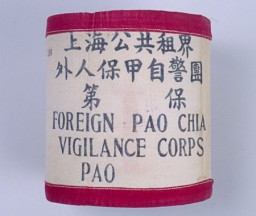
Scale used by refugees Masza Swislocki and George Lieberfreund to weigh jars of artificial honey, which they manufactured and sold in the restricted area of Shanghai. [From the USHMM special exhibition Flight and Rescue.]
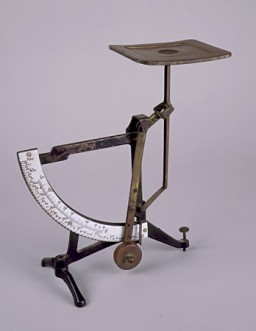
Portrait of Janek Goldstein, in pencil, by Yonia Fain. Goldstein, a friend of the artist in Shanghai, was the son of Bernard Goldstein, who was active in the Bundist underground of the Warsaw ghetto and participated in the 1943 uprising. [From the USHMM special exhibition Flight and Rescue.]
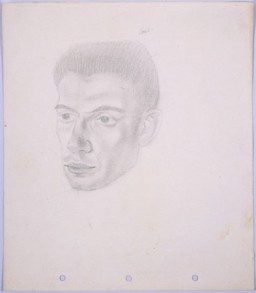
Portrait of Semek Kushner, in pencil, by Yonia Fain. Kushner's father and brother were killed in Shanghai near the end of the war during an American air raid on Hongkew. [From the USHMM special exhibition Flight and Rescue.]
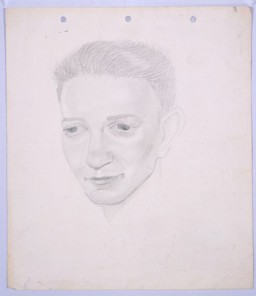
Program for an evening performance sponsored by the Shanghai Jewish Club. The program included the play "The Day of His Return" and a concert of Jewish songs. On April 27, 1943, the day of this performance featuring Warsaw Jewish actress Raya Zomina, fierce fighting continued in the Warsaw ghetto between German troops and Jews who chose to resist Nazi efforts to liquidate the ghetto. Terrifying rumors about the Holocaust reached the Jewish refugees in Shanghai, but they did not receive reliable news or…
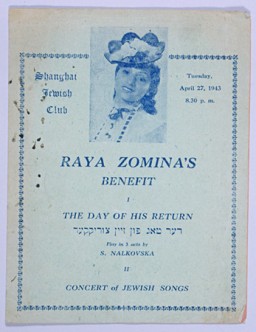
A Rosh Hashanah (Jewish New Year) greeting card. Sorle and Shalomis Gorfinkel presented this card to their parents on the occasion of Rosh Hashanah 5704, the Jewish New Year 1943. The Gorfinkel family was part of the Mir Yeshiva community in Shanghai.
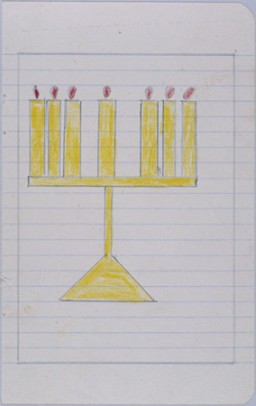
A Passover Haggadah published by rabbinical students in Shanghai in 1943. [From the USHMM special exhibition Flight and Rescue.]

Zionist poster produced by a Jewish organization in Shanghai commemorating the anniversary of Vladimir Jabotinsky's death, 1944.
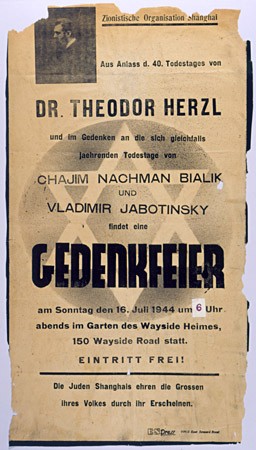
One of many signs displayed along the Shanghai ghetto's boundaries: "Stateless Refugees are Prohibited to Pass Here without Permission". This plaque was removed by a refugee at the end of the war. [From the USHMM special exhibition Flight and Rescue.]
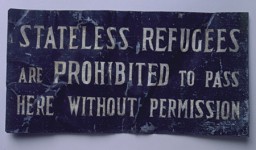
Pants worn by Marjan Glass as he dug anti-tank ditches for the defense of Warsaw, Poland, and then as he hastily fled the city ahead of the German advance on September 7, 1939. Glass, a lawyer, escaped with his wife and three-year-old son, and his wife's mother and brother. He left without taking the time to change from his soiled work clothing. [From the USHMM special exhibition Flight and Rescue.]

A seven-day gold traveling clock in a leather case, manufactured in France and originally made for a Russian nobleman. The panel in the leather case slides open to reveal the clock face. The clock was a Szepsenwol family heirloom. It was acquired by Chaya Szepsenwol's grandfather, who like her father, was a jeweler. The clock was among the family valuables that Rikla Szepsenwol was able to take out of Poland. [From the USHMM special exhibition Flight and Rescue.]
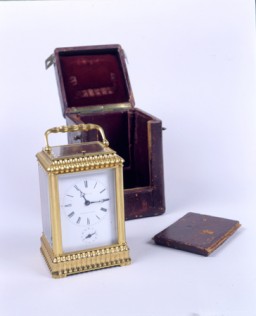
This poster from Munich, Germany, proclaims the April 1, 1933, boycott of Jewish-owned businesses and services offered by Jewish professionals. It calls on all Germans to honor the boycott, which began at 10 a.m. The poster was signed by the radical Nazi antisemite, Julius Streicher, official organizer of the boycott.
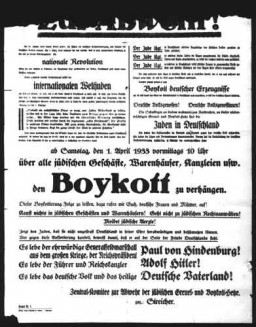
The program cover for "We Will Never Die" featured Arthur Szyk’s "Tears of Rage" artwork. The cover's original dimensions are: 12 1/16" x 9 1/16" x 3/16.
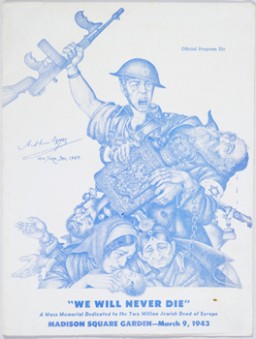
View of the countryside in Csobanka, Hungary, as the Hungarian Labor Service company 109/13 departs on the morning of April 20, 1942. [Photograph #57952]
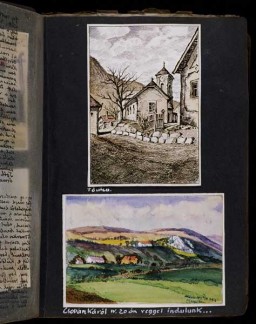
(Bottom) In a drawing dated April 18, 1942, Beifeld shows the school where the Hungarian Labor Service company 109/13 was quartered in Csobanka (Szentendre district), Hungary, before its departure for the Ukraine. A group of Hungarian soldiers [assigned to the labor service company] sits outside in the schoolyard. [Photograph #57947]

In a drawing dated April 14, 1942, Beifeld shows houses in Csobanka (Szentendre district), Hungary, where the Hungarian military officers assigned to the labor service company were quartered before their departure for the Ukraine. [Photograph #57949]

We would like to thank Crown Family Philanthropies, Abe and Ida Cooper Foundation, the Claims Conference, EVZ, and BMF for supporting the ongoing work to create content and resources for the Holocaust Encyclopedia. View the list of donor acknowledgement.